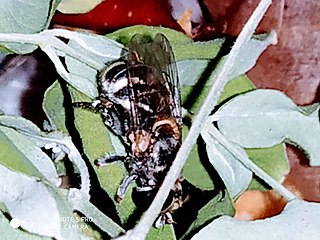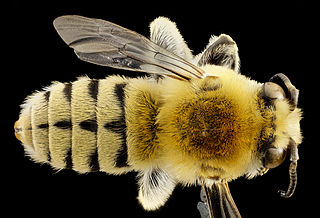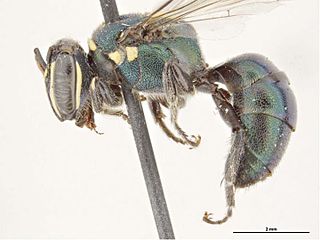
Carpenter bees are species in the genus Xylocopa of the subfamily Xylocopinae. The genus includes some 500 bees in 31 subgenera. The common name "carpenter bee" derives from their nesting behavior; nearly all species burrow into hard plant material such as dead wood or bamboo. The main exceptions are species in the subgenus Proxylocopa, which dig nesting tunnels in suitable soil.

Thyreus is an Old World genus of bees, one of many that are commonly known as cuckoo bees, and are cleptoparasites of other species of bees, mostly in the genus Amegilla. They all have strongly contrasting patterns of coloration - three species from the Sydney region, Thyreus nitidulus, T. lugubris, and T. caeruleopunctatus are bright blue and black.

Thyreus nitidulus, commonly known as the neon cuckoo bee, is a parasitic bee of the genus Thyreus, called cuckoo bees. It is a stocky bee, notable for its brilliant metallic blue- and black-banded colors.
Lasioglossum semisculptum, also known as the Lasioglossum (Ctenomia) semisculptum, is a species of bee in the genus Lasioglossum, of the family Halictidae.

Lasioglossum halictoides, also known as the Lasioglossum (Nesohalictus) halictoides, is a species of bee in the genus Lasioglossum, of the family Halictidae.
Lasioglossum serenum, also known as the Lasioglossum (Nesohalictus) serenum, is a species of bee in the genus Lasioglossum, of the family Halictidae.

Pseudapis oxybeloides is a species of bee in the genus Pseudapis, of the family Halictidae. It is a soil nesting type of bee. It is known to be a major insect pollinator in the world.
Anthidiellum butarsis is a species of leaf-cutting bee in the genus Anthidiellum, of the family Megachilidae.
Anthidiellum krombeini is a species of leaf-cutting bee in the genus Anthidiellum, of the family Megachilidae.
Coelioxys angulata is a species of leaf-cutting bee in the genus Coelioxys, of the family Megachilidae.
Coelioxys fuscipennis is a species of leaf-cutting bee in the genus Coelioxys, of the family Megachilidae. It is found in India, and recordings from Sri Lanka is uncertain.
Coelioxys formosicola is a species of leaf-cutting bee in the genus Coelioxys, of the family Megachilidae.
Tetraloniella taprobanicola, also known as Tetraloniella (Tetraloniella) taprobanicola, is a species of bee belonging to the family Apidae subfamily Apinae. It is found endemic to Sri Lanka.
Thyreus histrio, is a species of bee belonging to the family Apidae subfamily Apinae.
Thyreus insignis, is a species of bee belonging to the family Apidae subfamily Apinae.
Thyreus surniculus, is a species of bee belonging to the family Apidae subfamily Apinae. It is found in India, Sri Lanka and occasionally Pakistan.
Thyreus takaonis, is a species of bee belonging to the family Apidae subfamily Apinae.

Habropoda is a genus of anthophorine bees in the family Apidae. There are at least 50 described species in Habropoda.

Palaeorhiza is a genus of bees belonging to the family Colletidae.





